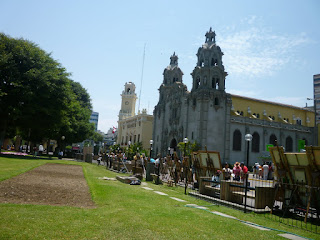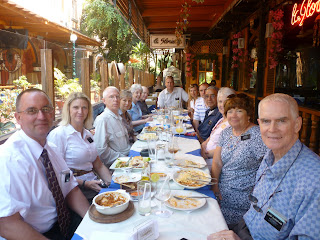From a hole in the ground to an 8-story 5-star hotel...for 18 months we watched the construction of a hotel from the window of the Lima Central Mission. Every Monday, when we went to the office for the Central and South Missions clinic, I took a picture. No one knows who is building the luxury hotel.
 For a few weeks all the materials were on a knoll where the crane is sitting. The excavation was done in the front left corner. Then the materials were placed by crane on the back left corner while the platform to the right was being constructed. The platform then became the place for the pile of metal and sheetrock while the rock and dirt were excavated in the back left corner.
For a few weeks all the materials were on a knoll where the crane is sitting. The excavation was done in the front left corner. Then the materials were placed by crane on the back left corner while the platform to the right was being constructed. The platform then became the place for the pile of metal and sheetrock while the rock and dirt were excavated in the back left corner. Later we learned that platform was the roof of the underground parking. You can see the retaining wall in the right corner. The people living in the house on the other side of the wall refused to move. We could understand their reluctance to give up their Colonial era home even though they lost their back yard and privacy. There are no windows on that side of the hotel as far as we could tell.
Later we learned that platform was the roof of the underground parking. You can see the retaining wall in the right corner. The people living in the house on the other side of the wall refused to move. We could understand their reluctance to give up their Colonial era home even though they lost their back yard and privacy. There are no windows on that side of the hotel as far as we could tell. The picture does not show the second steam shovel working to excavate the last remaining pile of rock and dirt but the two steam shovels worked for two or three weeks two level what had been the ramp for the trucks carrying away the debris.
The picture does not show the second steam shovel working to excavate the last remaining pile of rock and dirt but the two steam shovels worked for two or three weeks two level what had been the ramp for the trucks carrying away the debris. There were times when we thought this crane was going to come through the windows of the Central Mission office. And...we thought the crane operator was one brave soul to climb the ladder into the cab of the crane. It was also fascinating to watch the additions to the crane as the hotel grew.
There were times when we thought this crane was going to come through the windows of the Central Mission office. And...we thought the crane operator was one brave soul to climb the ladder into the cab of the crane. It was also fascinating to watch the additions to the crane as the hotel grew.  We didn't count the number of construction workers but there must have been 100 men on the job. Security was tight--three or four security officers were on site at all times. The construction workers wore colorful hard hats and uniforms depending on their rank and tasks.
We didn't count the number of construction workers but there must have been 100 men on the job. Security was tight--three or four security officers were on site at all times. The construction workers wore colorful hard hats and uniforms depending on their rank and tasks. The lobby is visible on the right. The two-story parking terrace is below and will be accessed from the back of the hotel.
The lobby is visible on the right. The two-story parking terrace is below and will be accessed from the back of the hotel. The floors are now all in place in this picture.
The floors are now all in place in this picture. This picture shows the windows going in and the decorative front being placed on the hotel.
This picture shows the windows going in and the decorative front being placed on the hotel. I like this picture because it shows some of the district of San Isidro. The original Lima South Mission home is not far from here. Also a few blocks to the right is the sacred pre-Inca huallca with the steep ramp which we toured with Margaret and Ted and Emma, Spencer, and Kate when they visited us in August.
I like this picture because it shows some of the district of San Isidro. The original Lima South Mission home is not far from here. Also a few blocks to the right is the sacred pre-Inca huallca with the steep ramp which we toured with Margaret and Ted and Emma, Spencer, and Kate when they visited us in August.












